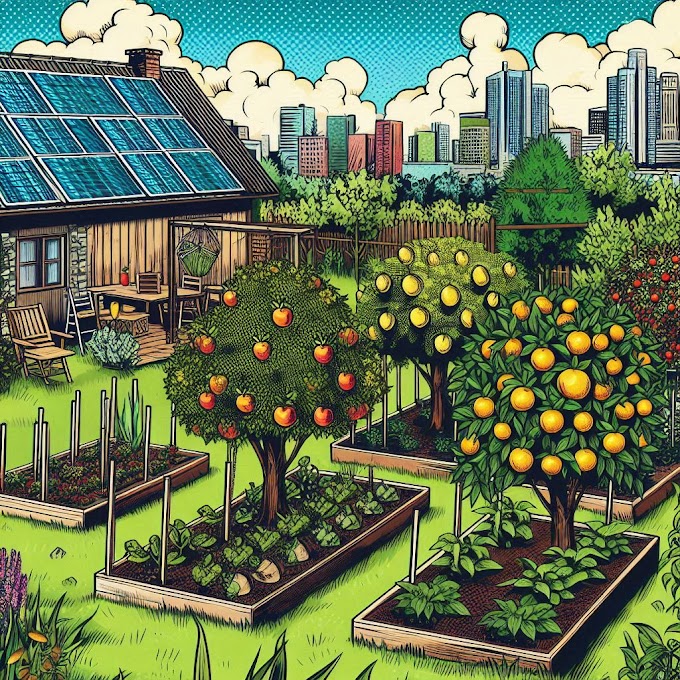Advanced Survival Gardening: Thriving Beyond the Basics

So, you’ve set up your survival garden—congratulations! You’re already on the path to self-reliance and sustainability. But survival gardening is not just about growing food; it’s about building a resilient, self-sustaining system that thrives year after year. This article will help you take your survival garden to the next level, focusing on advanced techniques, strategies for year-round production, and integrating nature’s ecosystems to work in your favor.
Step 1: Diversify Your Crops
1. Focus on Perennials
While annual crops are great for quick harvests, perennials are your garden’s long-term backbone. They require less maintenance and return year after year. Consider:
Fruits: Blueberries, raspberries, figs, and hardy kiwis.
Vegetables: Artichokes, asparagus, and perennial onions.
Herbs: Rosemary, sage, and lavender.
2. Experiment with Uncommon Crops
Adding lesser-known plants increases diversity and resilience. Try:
Jerusalem Artichokes: A prolific, high-calorie root vegetable.
Amaranth: A dual-purpose plant with edible leaves and seeds.
Malabar Spinach: A heat-tolerant, vining green.
Step 2: Implement Advanced Techniques
1. Build a Food Forest
A food forest mimics natural ecosystems by layering plants to create a self-sustaining environment. Layers include:
Canopy: Fruit or nut trees.
Understory: Shrubs like currants or elderberries.
Ground Cover: Herbs and low-growing vegetables.
Root Layer: Potatoes, carrots, and garlic.
This approach maximizes space and creates a natural balance between plants, soil, and wildlife.
2. Create a No-Till System
No-till gardening preserves soil structure and microbial life, which are crucial for healthy crops. To start:
Lay down cardboard or newspaper to suppress weeds.
Add a thick layer of compost and mulch on top.
Plant directly into this nutrient-rich layer.
3. Use Companion Planting to Maximize Output
Pair plants that benefit each other:
Three Sisters: Corn, beans, and squash grow harmoniously, with each crop supporting the others.
Tomatoes and Basil: Basil deters pests and improves tomato flavor.
Step 3: Extend Your Growing Season
1. Use Cold Frames and Hoop Houses
Protect crops from frost and extend your harvest into colder months. These structures are easy to build and maintain, even in small gardens.
2. Grow Indoors During Winter
Herbs, microgreens, and even dwarf varieties of vegetables can thrive indoors under grow lights.
3. Stagger Planting
For continuous harvests, plant new seeds every few weeks. This ensures you always have something to pick, even during off-seasons.
Step 4: Enhance Soil Health
1. Rotate Crops Intelligently
Prevent soil exhaustion by rotating crop families annually. For example:
Year 1: Grow legumes (beans, peas) to fix nitrogen.
Year 2: Follow with heavy feeders like tomatoes or squash.
Year 3: End with root vegetables to aerate and improve soil.
2. Make Your Own Fertilizer
Compost: Kitchen scraps and garden waste become rich, organic matter.
Bone Meal: Provides phosphorus for root development.
Wood Ash: Adds potassium but should be used sparingly to avoid altering soil pH.
3. Incorporate Cover Crops
Plant cover crops like clover or rye during the off-season to prevent erosion, suppress weeds, and enrich the soil with organic matter.
Step 5: Protect Your Garden
1. Encourage Beneficial Insects
Attract pollinators like bees and butterflies by planting flowers like sunflowers, zinnias, and marigolds. Ladybugs and lacewings can help control pests naturally.
2. Install Physical Barriers
Use netting or fencing to keep out deer, rabbits, and other critters.
Raised beds can deter burrowing pests.
3. Create a Natural Pest Control System
Trap Crops: Plant sacrificial plants like nasturtiums to lure pests away.
DIY Sprays: A mix of garlic, water, and dish soap can deter aphids and mites.
Step 6: Preserve and Store More Effectively
1. Master Fermentation
Fermented foods like sauerkraut and kimchi are rich in nutrients and probiotics, making them excellent for long-term storage.
2. Build a Root Cellar
If space allows, a root cellar keeps root vegetables, squash, and apples fresh for months.
3. Solar Drying
A solar dehydrator is an eco-friendly way to preserve fruits, herbs, and vegetables.
Step 7: Incorporate Livestock and Aquaponics
1. Add Small Livestock
Chickens, ducks, or rabbits can provide eggs, meat, and manure for your garden.
2. Try Aquaponics
This innovative system combines fish farming with hydroponic gardening. Fish waste fertilizes plants, and plants filter water for the fish—a self-sustaining cycle.
Step 8: Prepare for the Unexpected
1. Save Heirloom Seeds
Heirloom seeds are non-GMO and adapt to your local climate over time. Save seeds from your healthiest plants for future planting.
2. Create a Seed Bank
Stockpile a variety of seeds in waterproof, airtight containers to ensure a diverse future harvest.
Step 9: Build a Community Network
Share knowledge, seeds, and surplus produce with neighbors. A gardening community can offer support, trade, and collaboration during challenging times.
An advanced survival garden is more than just a food source—it’s a thriving ecosystem, a classroom, and a beacon of hope in uncertain times. By diversifying your crops, implementing innovative techniques, and integrating sustainable systems, you can create a garden that not only sustains you but grows with you.
The journey doesn’t end here—continue learning, experimenting, and cultivating your lifeline. With every seed planted, you’re building resilience for the future.













